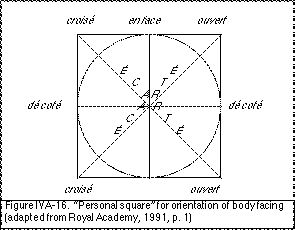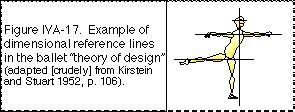
Evidence for the prototypicality of dimensions and pure diagonals (and correspondingly of 90° and 45° angles) in conceptions of body movement are also found in the conceptual structure of ballet which is based almost entirely on dimensional directions. It is not surprising that ballet is a perfect example of the prototype/deflection hypothesis since Laban (1926, pp. 6-12) explicitly used the ballet model in his conceptual development of choreutics (see IVA.81).
IVA.61 Ballet Facing.
The directional orientation of body facings in ballet, known as the “directions of épaulement” or the “eight directions of the body” (Grant, 1982), is conceived according to a square with dimensional orientations directed toward the edge midpoints, and diagonal orientations directed toward the corners (Fig. IVA-16). These directions are commonly presented in ballet manuals as diagonal and dimensional lines through the centre of a square (Bazarova and Mey, 1987, p. 49; Grant, 1982, p. 125; Hammond, 1974, p. 65).

Diagonal facings (ie. 45° to the front of the stage space) are indicated with the French terms “croisé” (legs crossed), “effacé” or “ouvert” (legs open), “épaulée” (front shoulder crossing the body) and “écarté” (leg wide to the side). Dimensional facings are referred to with the French terms “en face” (facing the audience) or “de coté” (facing the side of the room). The orientation of the limbs relative to the body and the orientation of the body relative to the room are usually combined within the terminology for the different facings (Grant, 1982, p. 91). In some cases the egocentric/exocentric forward dimensional facing is not stated but is assumed as a (prototypical) default value, for example, “á la quatriéme” (“fourth position” of the feet while facing front) and “á la seconde” (“second position” of the feet while facing front).
IVA.62 Ballet Limb Orientation.
The orientations of limb positions and movements in ballet are also described in terms of dimensional and diagonal prototypes. A body-relative dimensional conception is evident within the Ballet positions of the feet. The vertical dimension is emphasized in the first, third and fifth positions where the two feet are pressed together. The sagittal dimension is emphasized in the fourth position where one foot is placed in front of (or behind) the other. The lateral dimension is emphasized in the second position where one foot is placed to the side of the other. Laban (1926, pp. 6–12) examined these dimensionally conceived ballet feet-positions together with the corresponding ballet arm-positions, and identified how they deflect into inclinations during their actual performance (see IVA.81).
The sagittal dimension is specified in ballet in many ways with the French “en avant” or “en descendant” (stage-forward) or “devant” (body-forward), “an arriere” or “en reculant” (stage-backward) or “derriere” (body-backward). In contrast, all room-relative diagonal directions for locomotion are referred to collectively as “en diagonale”.

Limb orientations relative to the body’s vertical dimension are referred to as the “angle of the leg in the air”, “positions of the leg in the air” or in the French “positions soulevées” (raised positions). These specify how high the leg is to be lifted (Grant, 1982). The initial distinction is between “á terre” (on the ground) in which the toe retains contact with the floor (angle with the vertical dimension is not specified), and “en l’ air” (in the air) in which the leg is raised further and is not in contact with the floor. When the leg is raised in the air to a 45° angle with the vertical it is specified with the French “á la demi-hauteur” (to the half-height) and a 90° angle with the vertical is specified with “á la hauteur” (to the height).
The demi-hauteur (45°) position is conceived to be either within the frontal or the medial plane and so corresponds with choreutic diameters. This is one of the few body-relative non-dimensional directions which are specified in ballet. However, because of anatomical constraints many deflected directions occur during ballet movements (see IVA.70).
IVA.63 Ballet conceptual grids.
The prototypicality of dimensions in the ballet conception is also evident in visual illustrations where dimensional lines are superimposed over drawings of the human body to illustrate part of the “space module” and the “theory of design” for basic ballet positions in the classic text by Kirstein and Stuart (1952, pp. 2, 20, 30, 81,104, 106) (Fig. IVA-17). These dimensional line reference grids are a similar type of abstracted conceptual representation as the cubic and octahedral networks used by Laban (see IVA.20).
IVA.64 Deflected Ballet.
Ballet movements can be analysed to determine their dimensional (or other) conception and their actual deflected body performance. An explicit knowledge of these inclinational vectors implicit in ballet movements can bring increased mental and physical understanding. Conceiving of movement as dimensional/diagonal deflections can be used to develop a deflected, organic, inclinational-based, para-ballet technique. Analyses of typical deflections from several common ballet movements showed that this is a practical, informative, and potentially revolutionary undertaking for future research (see Appendix XII).